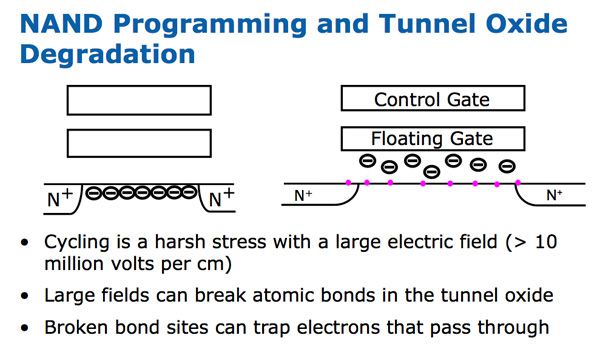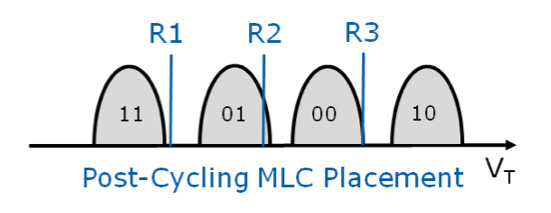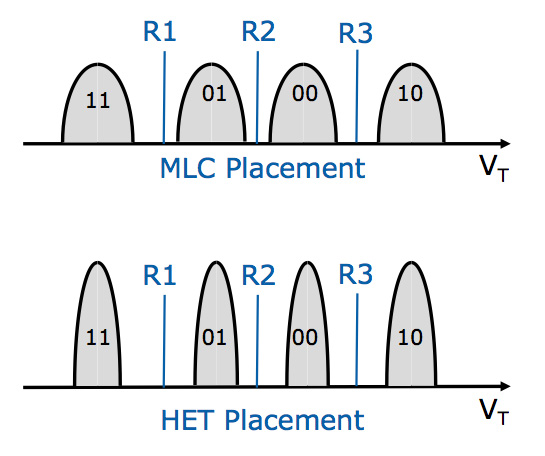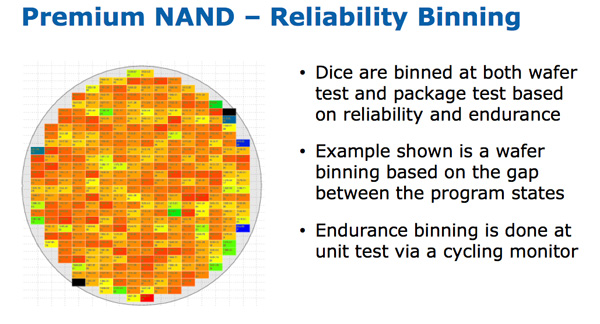The Intel SSD 710 (200GB) Review
by Anand Lal Shimpi on September 30, 2011 8:53 PM EST- Posted in
- Storage
- SSDs
- Intel
- Intel SSD 710
NAND Recap
Flash memory is non-volatile storage and in that sense it's similar to a hard drive. Once you write to a NAND flash cell it can store that data for an extended period of time without power.
You write to NAND through a quantum tunneling process. Apply a high enough voltage across a floating-gate transistor and some electrons will actually tunnel through an insulating oxide layer and remain on the floating gate, even when the voltage is removed. Repeated tunneling can weaken the bonds of the oxide, eventually allowing electrons to freely leave the floating gate. It's this weakening that's responsible for a lot of NAND endurance issues, although there are other elements at play.

NAND is programmed and read by seeing how each cell responds to various voltages. This chart shows the difference between MLC (multi-level-cell) and SLC (single-level-cell) NAND:

Both types of NAND are identical architecturally, it's just a question of how many voltages you map to bits on the cell. MLC (2-bit-per-cell ) has four different voltage levels that correspond to values while SLC only has two. Note that each value can correspond to a distribution of voltages. As long as the threshold voltage falls within that range, the corresponding value is programmed or read.
The white space in between each voltage distribution is the margin you have to work with. Those blue lines above are read points. As long as the voltage distributions don't cross the read points, data is accessed correctly. The bigger the margin between these points, the more write cycles you'll get out of your NAND. The smaller the margin, the easier it is to produce the NAND. It's easier to manufacture NAND that doesn't require such precise voltages to store and read data from each cell. Over time physical effects can cause these voltage distributions to shift, which ultimately leads to cell failure.
As MLC NAND gets close to the end of its life, these margins start narrowing considerably. Continuously programming and erasing NAND cells weakens the oxide, eventually allowing electrons to become stuck in the oxide itself. This phenomenon alters the threshold voltage of the transistor, which in turn shifts bit placements:

There's now ambiguity between bits which, if this cell were allowed to remain active in an SSD, would mean that when you go to read a file on your drive there's a chance that you won't actually get the data you're requesting. A good SSD should mark these bits bad at this point.
There's a JEDEC spec that defines what should happen to the NAND once its cells get to this point. For consumer applications, the NAND should remain in a read-only state that can guarantee data availability for 12 months at 30C with the drive powered off. Manufacturers must take this into account when they test and qualify their NAND. If you're curious, JEDEC also offers guidelines on how to cycle test the NAND to verify that it's compliant.
By now we all know the numbers. At 50nm Intel's MLC NAND was rated for 10,000 program/erase cycles per cell. That number dropped to 5,000 at 34nm and remained at the same level with the move to 25nm. Across the industry 3,000 - 5,000 p/e cycles for 2x-nm 2-bit-per-cell MLC (2bpc) NAND is pretty common.
For desktop workloads, even the lower end of that range is totally fine. The SSD in your desktop or notebook is more likely to die because of some silly firmware bug or manufacturing issue than you wearing out the NAND. For servers with tons of random writes, even 5K p/e cycles isn't enough. To meet the needs of these applications, Intel outfitted the 710 with MLC-HET (High Endurance Technology) more commonly known as eMLC.
Fundamentally, Intel's MLC-HET is just binned MLC NAND. SLC NAND gets away with having ultra high p/e cycle counts by only having two bit levels to worry about. The voltage distributions for those two levels can be very far apart and remain well defined over time as a result. I suspect only the highest quality NAND was used as SLC to begin with, also contributing to its excellent endurance.
Intel takes a similar approach with MLC-HET. Placements are much more strict in MLC-HET. Remember what I said earlier, narrow ranges of voltages mapping to each bit level reduces the number of NAND die that will qualify, but you build in more margin as you cycle the NAND. If placements do shift however, Intel's SSD 710 can actually shift read points as long as the placements aren't overlapping.

Similar to frequency binning CPUs, the highest quality NAND with the tightest margins gets binned into MLC-HET while everything else is shipped as standard MLC. And just like with frequency binning, there's a good chance you'll get standard MLC that will last a lot longer than it's supposed to. In fact, I've often heard from manufacturers that hitting up to 30K p/e cycles on standard MLC NAND isn't unrealistic. With its MLC-HET Intel also more frequently/thoroughly refreshes idle NAND cells to ensure data integrity over periods of extended use.

Intel performs one other optimization on MLC-HET. After you've exceeded all available p/e cycles on standard MLC, JEDEC requires that the NAND retain your data in a power-off state for a minimum of 12 months. For MLC-HET, the minimum is reduced to 3 months. In the consumer space you need that time to presumably transfer your data over. In the enterprise world, a dying drive is useless and the data is likely mirrored elsewhere. Apparently this tradeoff also helps Intel guarantee more cycles during the drive's useful life.

At IDF Intel told us the MLC-HET in the SSD 710 would be good for around 30x the write cycles of standard (presumably 25nm) MLC. If we use 3,000 as a base for MLC, that works out to be 90K p/e cycles for Intel's 25nm MLC-HET.










68 Comments
View All Comments
Stas - Sunday, October 2, 2011 - link
Makes you wonder: how did Anandtech survive in the olden days?Anand Lal Shimpi - Friday, September 30, 2011 - link
I didn't preview Bulldozer because it would've been a disservice to the community. The performance levels of chips we had access to prior to going under NDA with AMD just wasn't representative of anything.Don't worry, you'll get to hear about Bulldozer soon enough :) AMD said shipping in Q4...
Take care,
Anand
Voidman - Friday, September 30, 2011 - link
I actually would have agreed with this comment a lot more a year ago, or even 6 months ago. I am starting to see a few actual PC builder related reviews in recent months, and am happy about it. (Of course consumer SSD's are of interest to home builders, but that was about the only thing here that was). I was pleasntly surprised to see several reviews on cases/enclosures, something I have not seen here for a long time. And a PSU and monitor review here and there also. All of this came too late for my last build, but it is nice to see anyway.It does seem that there was a decision a couple of years ago to concentrate on smart phones and tablets and home theater gear, with SSD and enterprise IT articles filling in the gaps. I hope the recent trend of more PC builder related articles and reviews continues.
kevith - Saturday, October 1, 2011 - link
Apples products are interesting because they show the way. Tablets, phones and OS, they have the best. (And most expensive and hyped and with a congregation that's gross). But when Apple launches a product, EVERYONE else will try to copy it within months, whether you like it or not. Thats why its interesting reading.Enterprise hardware is interesting to read about because it shows what a new piece of hardware are ACTUALLY capable of. In this case it shows, that if you want a real reliable SSD, the "nickels and dimes", that a consumer-SSD costs is simply not enough.
THizzle7XU - Saturday, October 1, 2011 - link
"Apples products are interesting because they show the way."I actually feel like the media at this point puts Apple in a position to create a self fulfilling prophecy in this regard. The iPad is the greatest example of this. Before the iPad came out there were rumors for years, pretty much since the iPhone debut, that Apple was working on a tablet and how it would be the greatest thing ever. I feel like after the rumors went on for a while, Apple was like, "Ya, this thing sounds cool! Maybe we should build a tablet!". And then all the other manufactures sat on their hands while the obvious was happening waiting for Apple to release the design template when the blueprint was crystal clear for tablets (i.e. just their phone OS on a bigger screen with slight modifications to the apps to take advantage of the screen res).
It's like Apple pays its competitors not to compete with its ideas until they have released their product. And they everyone else becomes a copy cat of ideas that were so painfully obvious in the first place because they inexplicably waited until Apple released their version.
Stas - Sunday, October 2, 2011 - link
How dare you?! Steve Jobs created the universe. zOMG I'm getting wet dreaming about iPhone 5 !!!11!11!111inplainview - Sunday, October 2, 2011 - link
I must suck being you....Hulk - Friday, September 30, 2011 - link
I've been here from day one and Anand keeps getting better. In my opinion he has always been the best tech writer on the internet and now I see his thoughts are as clear an organized when doing a video review. Bravo!Kudos to all of the guys on the Anandtech site. The flavor of all of the reviews flows down to everyone here. Anand is still the best but luckily he is rubbing off on all his guys.
wxrkny - Friday, September 30, 2011 - link
"Anand is still the best but luckily he is rubbing off on all his guys."I hope not, that's gross
sorry I had to
TommyAU - Friday, September 30, 2011 - link
Haha